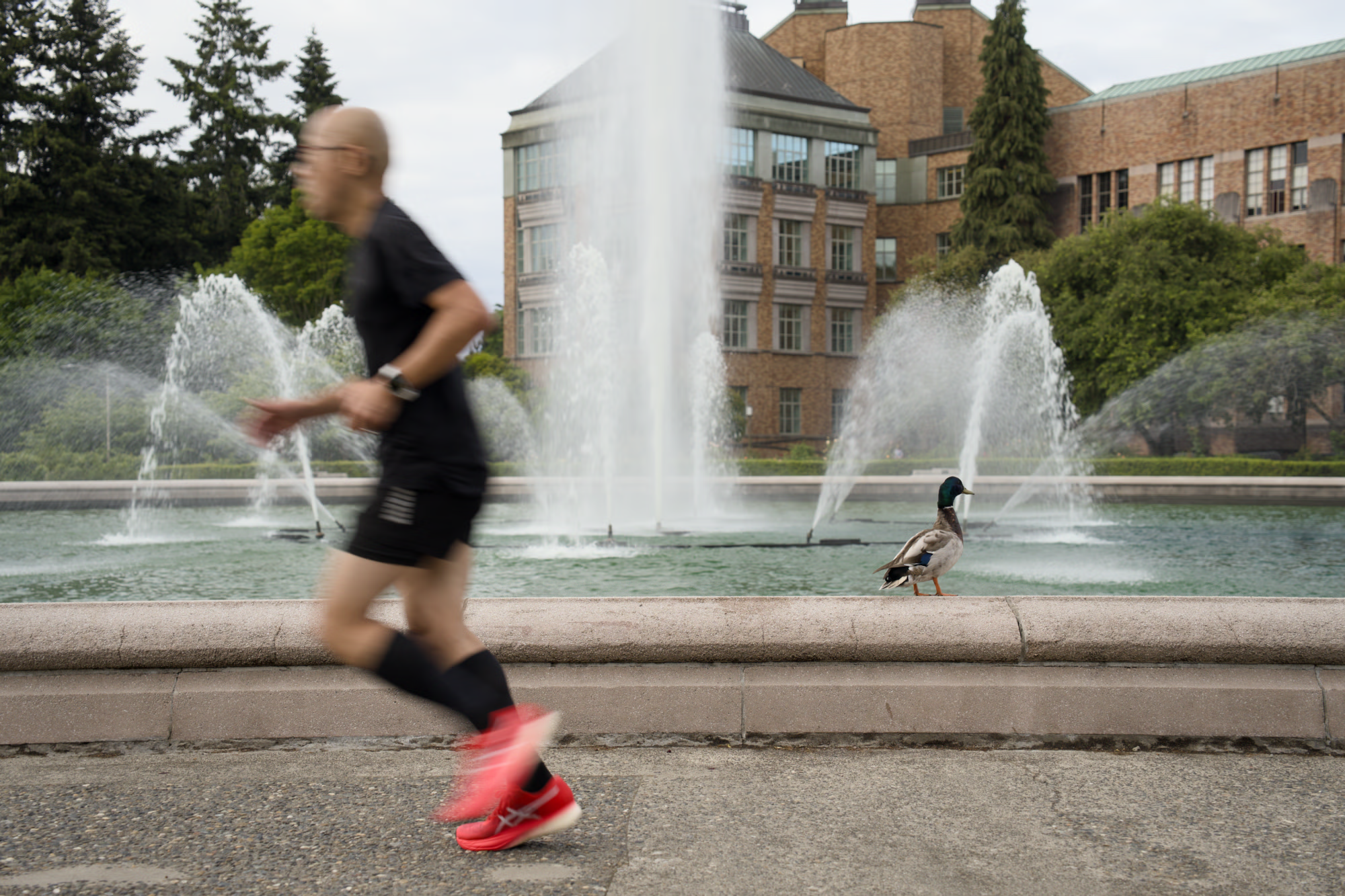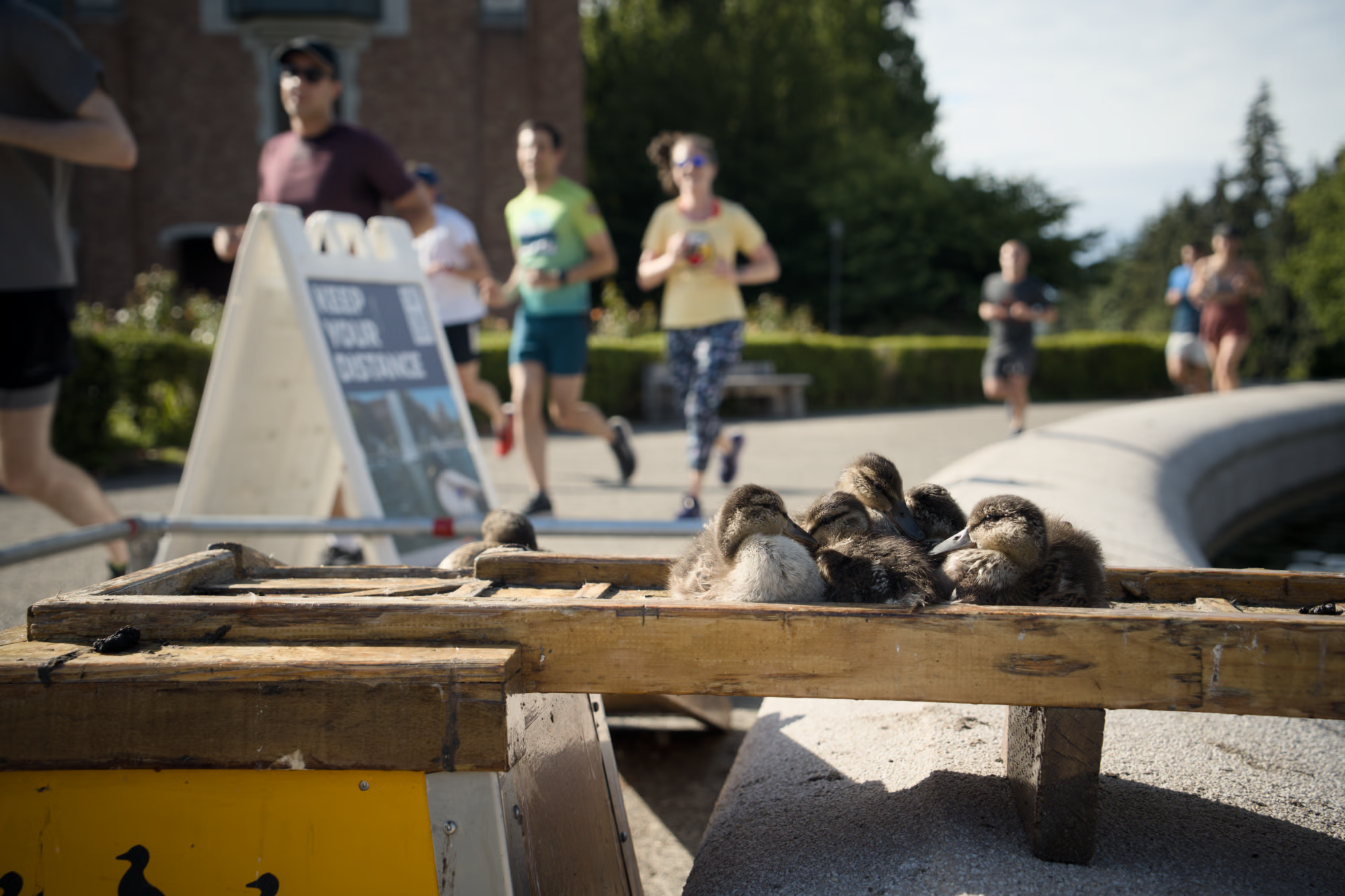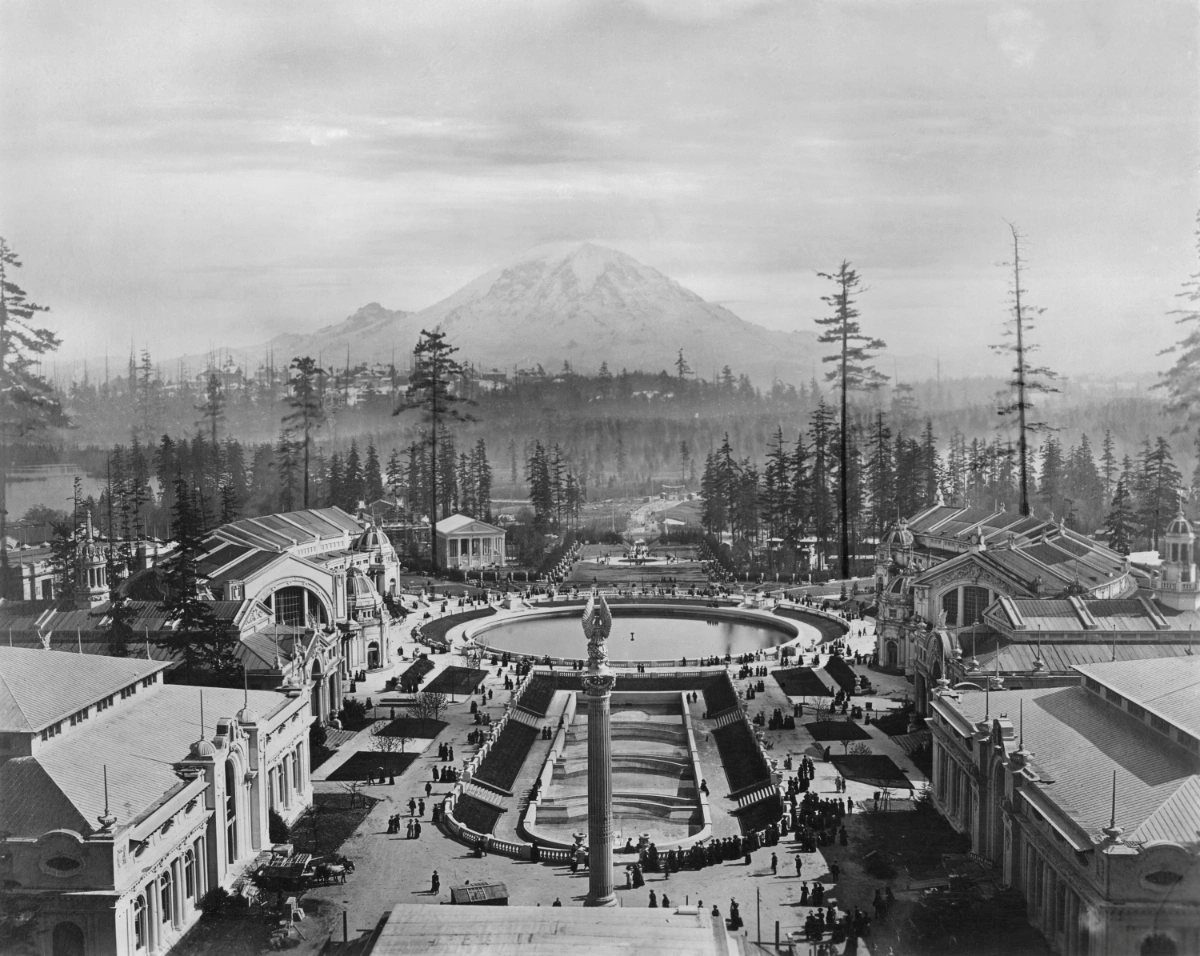Drumheller Marathon
will run June 1st, 2024.

Join us for laps around UW's historic fountain
La fille aux cheveux de lin - Claude Debussy


Join us for laps around UW's historic fountain
La fille aux cheveux de lin - Claude Debussy
The course consists of a short segment down the upper vista followed by laps around Drumheller Fountain and the duck ramp . The marathon comprises 219 laps and the half marathon consists of 109 laps. Both events will start at different times and locations. Participants aiming for fewer laps should start with the half marathoners.
The direction will flip every hour, and you must change directions only by rounding the marker placed at the edge of the finish line. We cannot provide you an official time unless you follow these instructions and complete the necessary number of laps.
While campus activity is reduced on weekends, expect to navigate around fountain-admirers, passers-by and cyclists. The course is not closed.
The course is served by the University of Washington light rail station. Minor service disruptions will be in effect on June 1st. Many bus routes stop at UW station or U District station.
Central Plaza Garage (CPG) beneath Red Square is the closest parking. See the University's page for rates and instructions.
Everything important is above, but participants should have also received the following by email:
Hello Drumheller runners,
Happy Race Day! The schedule is posted on the site.
Be at the start line early for instructions, and please bring a bottle with you. We'll have water but no cups.
If counting laps isn't enough and you'd like to time them too, here's a table with lap times for various goals.
See you in a bit,
—Nick Walker
Hello Drumheller runners,
We have a small number of shirts available for purchase with race-day pickup (order here). Note that we're giving visitors and guests priority, but we'll make another order if we end up short. Thanks to Chandra for making this happen.
Also attached is your unique live tracking credential for easy access (alternatively available at your link). There is some setup required, so take a look at the details and instructions on the site. Use it as a backup lap-counting method, but test before the race.
Forecast is looking good for running, bad for mountain-gazing. So it goes,
Nick Walker
[Unique participant QR code]
Hello Drumheller runners,
Race day approaches. Event details are on the site, and any updates will show up there too.
https://raceconditionrunning.com/dm24
We have a new live-tracking system this year. Usage is optional but highly encouraged, at least as a backup lap counting method. It's live now, and you can (should) test before the event. See the page for instructions. Your unique credential is linked below.
See you at the fountain next week!
--Nick Walker
[Unique participant URL]
No. Anyone running or walking fewer than 109 laps is welcome to join the half marathon. Here are some lap counts for common distances. Add a lap if not starting at the official start line.
| Distance | Laps |
|---|---|
| 5k | 26 |
| 10k | 52 |
| 10mi | 83 |
Excepting pacers, full marathon participants must intend to complete the full distance.
The cutoff times and corresponding average paces are:
| Distance | Time | min/mi | min/km |
|---|---|---|---|
| Marathon | 4:30:00 | 10:18 | 6:24 |
| Half Marathon | 3:00:00 | 13:43 | 8:31 |
On June 1, the temperature in Seattle typically ranges from 53°F to 66°F and is rarely below 48°F or above 76°F. [...] The coolest time of the day is from 1:00 AM to 8:00 AM, with the coldest at 5:30 AM, at which time the temperature is below 55°F three days out of four, and below 58°F nine days out of ten. [...] The cloudiest time of day is around 6:30 AM, at which time the chance of overcast or mostly cloudy conditions is 58%.
You can stash a bag near the aid station. You'll have line of sight the whole race, but they won't be attended.
Use a running watch to mark laps if you're wearing one, though you should check that it is capable of handling 100+ laps. GPS will clip the curve, so don't rely on it for more than a couple laps at a time. We'll have tally counters available if you prefer an analog counting aide.
Counting without assistance is not recommended.
The race will begin counterclockwise and alternate directions every hour to help balance the strain across your legs. Having the field run a single direction at a time will help us manage course congestion. Change directions only at the end of a lap and only by rounding the finish line marker.
Official times will be determined using a recorded video. It is critical that you run at least the required number of laps to ensure we can provide you an official time.
Finalizing the results can take weeks. Please use the live tracking system so that you can receive an unofficial time immediately, and to make it easier for us to mark times.
We can't guarantee spots until we know the overall makeup of the field. Here are some of the things we're taking into account:
Our goal is to confirm all applications by April 6th. We may close applications before then if the field fills.
Maybe. The answer will depend on your background, so please discuss with the organizers first if you would like to plan on Drumheller being your first marathon. As a rule of thumb, if you have not yet successfully completed a half marathon, you will have a better time doing that instead.
Yes. Runners intending to use pacers must submit a pacing plan with their application. Pacers can register after approval. Unlike most road races, we expect to be able to support rotating/non-starting pacers, however official times will only be given to participants who run the complete course.
Yes. In addition to the aid station there are benches surrounding the course. You must continue running the lap in the same direction as when you stopped or the lap will not count. To remove this possibility, we recommend you start and stop only on at the lap finish line so you can begin the next lap in either direction.
The half marathon field is larger and includes a broader range of paces, so we are scheduling to minimize the overlap between the two events. We plan under the assumption that the day will be warm with clear skies (the odds of this are something like 30%). We cannot start the half marathon much later than 8:00AM as we want those runners (many running their first half) to wrap up before the heat and sun pick up around 10:30AM. We may shift the start times if the forecast for the day is favorable. Note that the first trains start arriving to University of Washington Link station around 5:00AM on Saturdays.
Yes, the full marathon will meet the B.A.A. criteria for a qualifying race (see Rules and Policies pp.5-6 §2.2.1).
Yes, but not substantially. You will need to supply an additional centripetal force due to the curve, but the effect of this is likely less than 1% when running at world record marathon pace on a 30m radius. Because the force increases in the square of velocity, the effect is negligible for recreational runners. There are individual differences in running technique and physiology that may make the effect more or less pronounced for you. Consider practicing on the course or a track.
Unlikely. Many athletes train and race on smaller radius tracks without issue during indoor track season. There is evidence that consistently running the same direction on small indoor tracks over time leads to strength asymmetries which likely cause injuries. Alternating directions introduces rest and is probably sufficient to avoid acute issues for most runners.
You may also take comfort from knowing that indoor track marathons have been held for years without event.
Run from the start line and join us! You must enter the course from "behind" the finish line in the direction that the field is running at the time you join. So, if we're running counterclockwise, start your first loop by crossing over the finish line from the east, and otherwise from the west. Note that this event is gun time only.

Most people resist the idea of running long distances in circles. Those who don't are often examined in human-interest stories. But every year, Drumheller runners have a good time, and for many of them, the experience is better than the alternatives. For the devoted, a flat course and a table for bottles. For the novices, the constant company of peers.
The full marathon was a new test though, and I worried a little each time someone withdrew their registration (which happened three times). Would anyone run 200+ laps around a fountain?
So it's a joy that we got to celebrate the first four Drumheller Marathoners this year. They were joined by 21 half marathoners, just about equaling the number from the first two years of the event combined. Olivia Harris bettered the women's half course record (1:40:27), and Joe and yours-truly bettered the men's (1:27:33). Congratulations to the many who ran their first half or set their distance PR. Together, we ran 4227 laps.
The full distance raised the stakes. The prospect of qualifying times meant our timing camera had to work, and for hours longer than last year. The higher count is more difficult and the consequences for miscounting more wrenching.
But we met the challenge. Our finish line camera evolved into a lamppost mounted system. We developed better lap counting annotation tools, though it meant final results were delayed. And for the first time, we trialed a homegrown live lap counting service to give runners a fallback. Still, some half runners came up a lap short, so work remains.
Plenty went right, with plenty of assistance. Thanks, Zach, for getting us a dedicated Drumheller camera, Hannah and Theo for measurement help, Lauren for medal help, Chandra for shirt help, and Anshul for course marking. Thanks to Hannah and Sanjana for photos and for helping marathoners in the morning. Zach's "Drumheller Water" (Tailwind) and the on-course bottle table were aid station highlights. And thanks, Yuqian, for helping with annotation tools.
If you were inventing the marathon today, I'm not sure if you'd land on the big city marathon format. Squeezed police departments and wary city officials are loath to close streets, and the labor costs to do so are high and rising. The largest, most-successful races pencil out only with massive sponsorship deals, whose dollar amounts dwarf entry fees. All in service of relatively few runners.
We should cherish the city marathons that we have, but we should also explore sustainable alternatives. The Drumheller Marathon is one model. Like city races, it's easy to access because it happens where the community is, not a drive or a plane-ride away. Centering a single, meaningful location taps into our love of place, and whittles down essential support to the point where it can be supplied by one person.
More formal than a roundabout marathon, and on a shorter loop than any short-loop marathon, Drumheller is somehow closer to a "short track" marathon than anything else. It's a model worth repeating, but for now it remains a singular event.
Nick Walker

